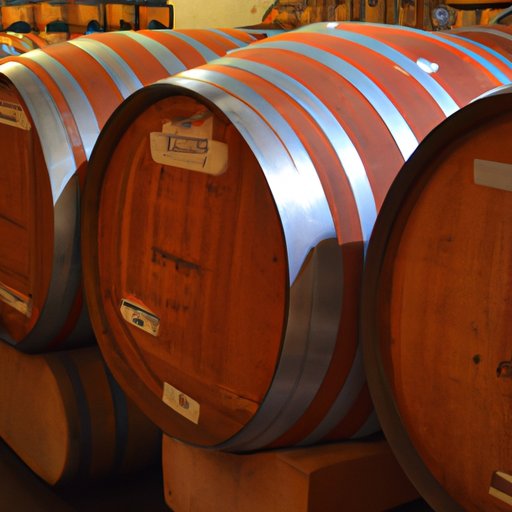Introduction
Sangiovese is one of the most widely planted grape varieties in Italy and is used to make some of the country’s most beloved wines. From Chianti to Brunello di Montalcino, the distinctive character of Sangiovese is unmistakable. But how does this classic Italian varietal age? In this article, we’ll explore the effects of aging on Sangiovese and uncover the best conditions for preserving its unique character.

Analyzing the Aging Qualities of Sangiovese Wine
When it comes to wine, aging can have a profound effect on flavor and aroma. As the components in the wine interact with oxygen, they break down and become more complex. This process can result in smoother, more integrated flavors and aromas. For Sangiovese, the effects of aging can be particularly pronounced. The high acidity and moderate tannin levels of this variety are well suited to long-term aging, resulting in deeper, more nuanced wines.
When it comes to flavor and aroma, aged Sangiovese often has notes of dried fruits, leather, earthiness, and tobacco. The complexity of these flavors can vary depending on the type of Sangiovese and the length of time it’s been aged. While light-bodied styles may take on more subtle notes of dried cherries and rose petals, full-bodied versions may have more intense flavors of blackberry jam, coffee, and tobacco.

Comparing Different Styles of Sangiovese and How They Age
In terms of body and structure, Sangiovese can vary significantly. Some styles are light-bodied and delicate, while others are full-bodied and robust. How each style ages can also differ. Light-bodied Sangioveses tend to be more acidic and lack the tannic structure needed for long-term aging. These wines can still develop interesting notes of dried fruit and spice, but they won’t benefit from long-term aging like fuller-bodied styles.
Full-bodied Sangioveses tend to have higher levels of tannins that can soften and integrate over time. These wines can develop complex layers of flavor and aroma with long-term aging and are likely to be better suited for cellaring. However, too much tannin can lead to an overly tannic wine if it’s aged for too long.
Understanding How Long Sangiovese Should Be Aged
The length of time a Sangiovese should be aged depends on the style and the desired outcome. Generally speaking, lighter-bodied styles should be consumed within two to three years of vintage, while fuller-bodied styles can benefit from five to ten years of aging. Of course, this is just a general guideline and every wine is different. Ultimately, it’s up to the individual to decide when the wine is ready to drink.
When it comes to long-term aging, there are several benefits to be had. Over time, the tannins will soften and the acidity will mellow, resulting in a more balanced and integrated wine. Furthermore, the flavors and aromas will become more complex as the components of the wine interact with oxygen. However, there are also risks associated with long-term aging. If a wine is aged for too long, the tannins can become overpowering, leading to an overly tannic and astringent wine.

Examining the Best Conditions for Aging Sangiovese
When it comes to aging Sangiovese, the right conditions are essential. Ideally, the temperature should be between 55 and 59 degrees Fahrenheit and the humidity should be between 50 and 70 percent. Keeping the wine away from light and vibration is also important. Cellaring in oak barrels can help impart additional complexity to the wine and is recommended for long-term aging.
In addition to the temperature and humidity, the wine needs to be stored in the proper environment. Ideally, the storage area should be dark, cool, and free from vibration. This will ensure that the wine develops in the most optimal way. Furthermore, storing the wine in oak barrels can help add complexity and depth to the wine over time.
Conclusion
Sangiovese is one of Italy’s most beloved wines and can benefit greatly from aging. When it comes to aging, the effects of time can be profound, resulting in deeper, more nuanced wines. Different styles of Sangiovese can age differently, so it’s important to consider the body and tannin levels before deciding how long to age the wine. It’s also important to store the wine in the optimal conditions and to avoid over-aging. With the right care and attention, Sangiovese can develop into something truly special.
References
Crowley, M. (2021, January 22). What Is Sangiovese Wine? Retrieved from https://www.thespruceeats.com/what-is-sangiovese-wine-4148488
Lange, K. (2018, August 29). What Are Tannins and How Do They Impact Wine? Retrieved from https://www.winefolly.com/tips/what-are-tannins-and-how-do-they-impact-wine/
Walsh, F. (2020, October 20). How to Age Wine at Home.Retrieved from https://www.winemag.
(Note: Is this article not meeting your expectations? Do you have knowledge or insights to share? Unlock new opportunities and expand your reach by joining our authors team. Click Registration to join us and share your expertise with our readers.)
